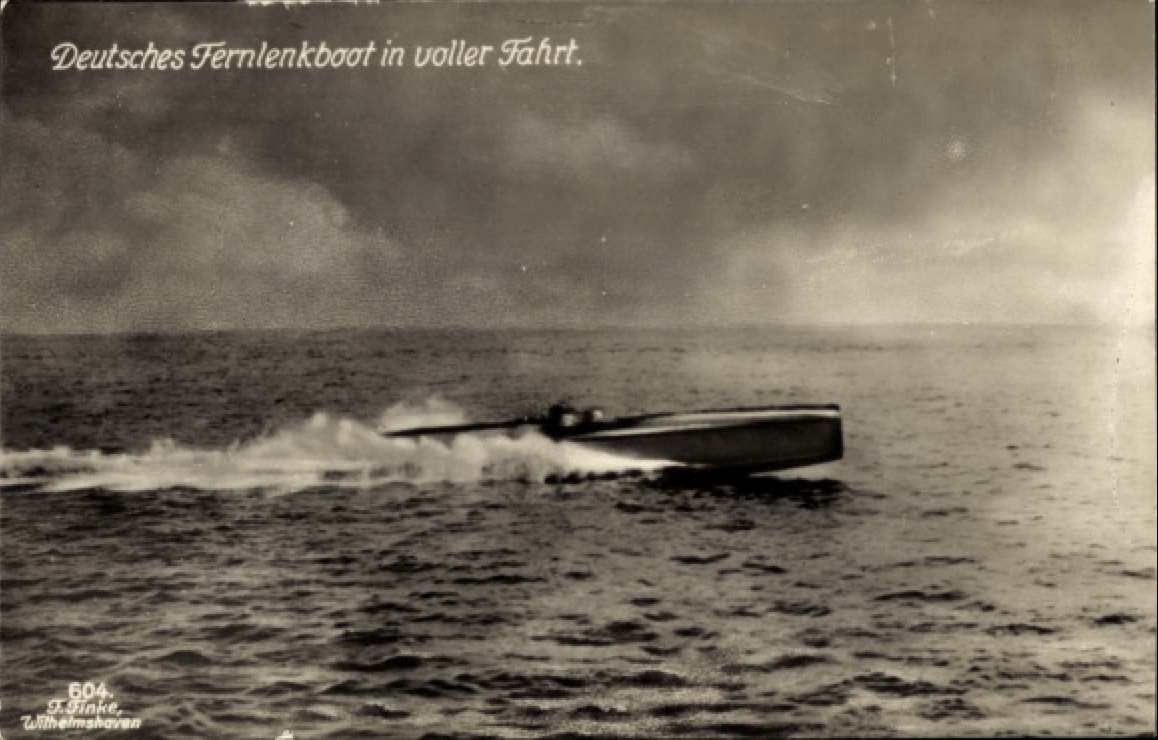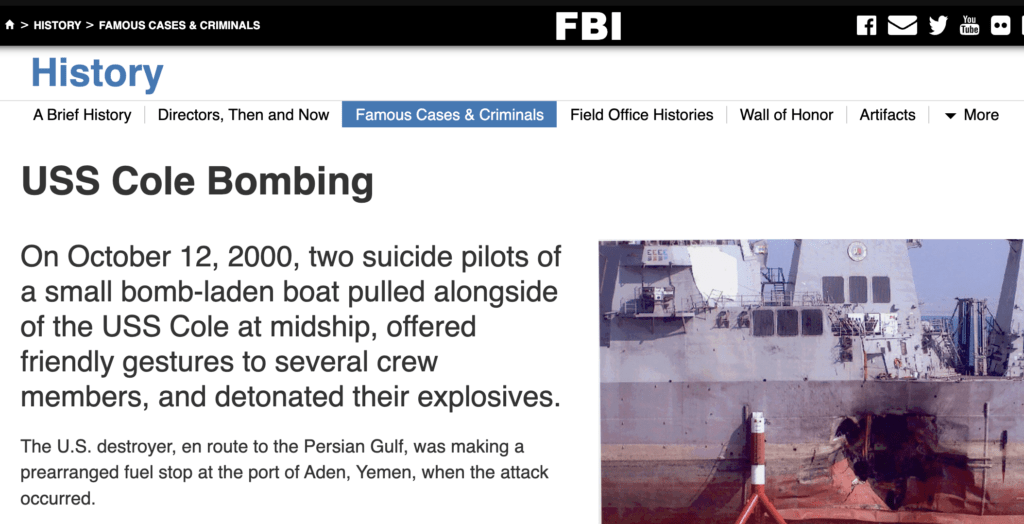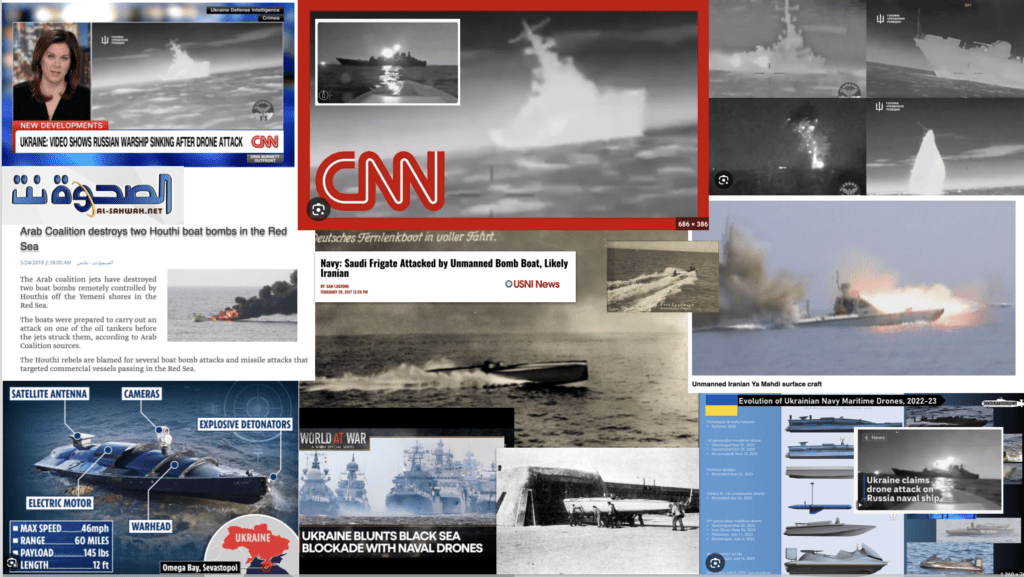The increasing use of unmanned explosive boats signals a shift in maritime conflict dynamics, where asymmetrical tactics can effectively challenge traditional naval dominance. Most recently, Ukraine announced it had successfully used sea drones to attack and destroy a Russian warship, the missile corvette Ivanovets, in the Black Sea near Crimea.
Ukraine’s recent use of sea drones against the Kerch Bridge and the Russian naval forces off Crimea underscores a significant leap in the sophistication and strategic application of these systems. According to reports, Ukraine deployed sea drones capable of carrying up to 300 kilograms (660 pounds) of explosives, highlighting the lethal efficiency and stealth capabilities of modern unmanned naval vessels. Earlier, with the Kerch bridge, unmanned surface vessels or USVs were carrying 850 kilograms of explosives to destroy the pillar of the bridge. In 2022, Ukrainians employed tracking devices and jet-ski motors to attack Russia’s Black Sea Fleet in the annexed Crimean port of Sevastopol.
Academic analyses, such as those from the Lieber Institute at West Point, suggest that the use of such drones not only changes the tactical dynamics of naval warfare but also raises significant legal and ethical considerations regarding the conduct of hostilities at sea.
The increasing use of unmanned explosive boats signals a shift in maritime conflict dynamics, where asymmetrical tactics can effectively challenge traditional naval dominance. This trend is likely to continue, with nations and non-state actors alike investing in the development of more advanced and autonomous naval drones. The role of robotics is particularly emphasized in coastal waters, narrow sea areas, and archipelagos.
Pre-robotic explosive boats
Underwater warfare dates up to the 1870s when the Irish John Philip Holland planned the first practical submarine, the Fenian Ram to attack the British Navy. Launched in 1881, the Fenian Ram never saw military action. However, its design was used by the US to build its own submarine fleet. John Holland became accredited as the father of the modern submarine.
Remote-controlled boats loaded with explosives were already used in the English Channel during the First World War. The German Imperial Navy had its own Fernlenkboot – remote-controlled boats, and the British experimented with radio control in their attacks on German naval ports. The end of the First World War also saw the first unmanned aerial vehicles, UAVs.

During World War II, the Japanese used not only suicide planes but boats, too.
Captured documents reveal a strategy where three boats would simultaneously approach a target ship, each aiming for a critical location to deploy their explosives. Unlike the outright suicidal missions associated with Kamikaze pilots or “Baka” bombs, the individuals manning these boats weren’t necessarily expected to die in the attack. The depth-charge igniters were set to a five-second delay. A Japanese officer noted that theoretically, it was possible to release the depth charges near a ship and then flee, although the boats’ lack of durability meant survival was improbable. Should they complete their mission, they were to be elevated to the rank of second lieutenant, although it was anticipated that most would receive such promotions after their death.
Iran, Iran, Iran
Worldwide, there has been a growing trend among terrorists to utilize small boats for launching attacks on military and commercial vessels, as well as maritime infrastructure. The strategies and methods employed in deploying or delivering improvised explosive devices (IEDs) via small boats have demonstrated their effectiveness and adaptability for use in various contexts.

The Iranians harassed tanker traffic using small boats during the Tanker War, and the anti-shipping campaigns during the Iran-Iraq War (1980-1988). In 2000, two suicide pilots of a small bomb-laden boat pulled alongside the USS Cole at midship, offered friendly gestures to several crew members, and detonated their explosives. The U.S. destroyer, en route to the Persian Gulf, was making a prearranged fuel stop at the port of Aden, Yemen, when the attack occurred. Al Qaeda operatives were believed to be behind the hit. In 2002, an explosive-laden boat rammed the French oil tanker Limburg. The ship was anchored about five miles off al-Dhabbah, Yemen. One person was killed and 4 were wounded. Al-Qaida was suspected.
In 2005, Lu’ai Sakra, an al Qaeda–linked organization utilized a small boat laden with high explosives and smashed it into an Israeli cruise ship carrying travelers destined for Turkey. In 2017, the Houthis were reported of used a drone boat to attack and hit a Saudi frigate. The unmanned boat was likely supplied by Iran. Tables turned in 2022, when the Islamic Republic of Iran Shipping Lines group (IRISL) announced, that an “explosive device” hit its ship, en route from Iran to Europe in the Mediterranean Sea.
Unmanned Vessels: A Strategic Asset
The evolution of naval warfare has taken a significant turn with the integration of robotics and remotely controlled systems, marking a new era where unmanned and AI-enabled technologies are at the forefront of maritime defence strategies. This technological shift is not only reshaping the operational tactics of navies worldwide but also redefining the future of maritime conflict and security.
Naval Technology reports on the increasing utilization of unmanned surface vessels (USVs) in a variety of missions across the globe. These autonomous ships, once primarily used for oceanographic surveying or as seaborne targets, are now being deployed for more complex and hazardous tasks such as surface warfare, mine warfare, and anti-submarine warfare. The U.S. Navy, for instance, is integrating these vessels into its Littoral Combat Ships (LCS) program, which plans to deploy Fleet-class USVs capable of high speeds and extended operations of up to 48 hours. This development highlights the strategic value of USVs in enhancing naval capabilities while minimizing risks to human life and reducing operational costs.
Task Force 59: Pioneering AI and Robotics in the Navy
The U.S. Navy’s Fifth Fleet, operating in strategically crucial and challenging regions like the Arabian Gulf and the Red Sea, has established Task Force 59 to spearhead the adoption of new robotic and artificial intelligence technologies. This initiative aims to bolster maritime domain awareness and enhance deterrence capabilities in congested waterways and adversarial environments. By integrating unmanned aerial, surface, and undersea vehicles, the Navy seeks to expand its surveillance reach and improve the processing and utilization of the vast data these systems generate. Task Force 59’s efforts to integrate AI and unmanned systems are expected to provide valuable insights that can be scaled across other fleets, demonstrating the potential of these technologies to operate effectively under extreme conditions.
Compared to the exploding suicide boats of the past, today’s robotics and autonomous systems in naval warfare represent a significant leap from those early attempts, offering unparalleled precision, endurance, and versatility. As these technologies continue to evolve, the integration of flying, quadrupedal, and swimming or diving robots into a unified framework of military assets will be crucial for maximizing their effectiveness.
Psychological Impact Still More Important
While Ukraine’s utilization of sea drones against Russian naval assets highlights the growing importance of unmanned systems in naval conflict, it also underlines the challenges of fully integrating these technologies into a cohesive military strategy. The psychological impact of these attacks currently surpasses their military effect, indicating that nations like Ukraine have considerable ground to cover in harnessing the full potential of these technologies. The journey toward effectively articulating the use of diverse robotic systems in warfare is complex, requiring not only technological advancements but also strategic innovation and international collaboration.
As naval warfare continues to be reshaped by robotics and autonomous systems, the global naval community stands on the cusp of a new age of conflict and defence. The advancements in unmanned vessels, combined with strategic initiatives like Task Force 59, are paving the way for a future where robotic and AI-enabled systems play a pivotal role in maintaining maritime security and deterrence.
Read More:
- National Defense Magazine: New Navy Task Force Focused on AI, Robotics
- Naval Technology: Autonomous & intelligent: the era of unmanned naval warfare
- Defense News: New Houthi weapon emerges – a drone boat
- Elgar Online: Maritime terrorism here and now – going global by Peter Lehr
- World Maritime University: Asymmetric threats and their challenges to freedom of navigation by K. R. Deepak Kumar
- US Department of State: Significant Terrorist Incidents, 1961-2003: A Brief Chronology
- Strauss Center: Strait of Hormuz – Assessing the threat to oil flows through the Strait
- FBI: History – Famous Cases And Criminals: USS Cole Bombing
- The New York Times: The Warship Explosion – The Overview Blast Kills Sailors On-US Ship In Yemen
- France24: Exploding, low-tech boats roil Russia’s Black Sea interests and standing
- U.S. Naval Institute: The Fenian Ram by Lieutenant Colby Rucker
- Friends of Sinn Fein: The Fenian Ram – The World’s First Military Submarine
- Singapore’s Ministry Of Defence: Maritime Terrorism Threat In Southeast Asia And Its Challenges by Joses Yau Meng Wee
- Radio Free Europe: Iran Reports ‘Terrorist Attack’ On Cargo Ship In Mediterranean Sea



